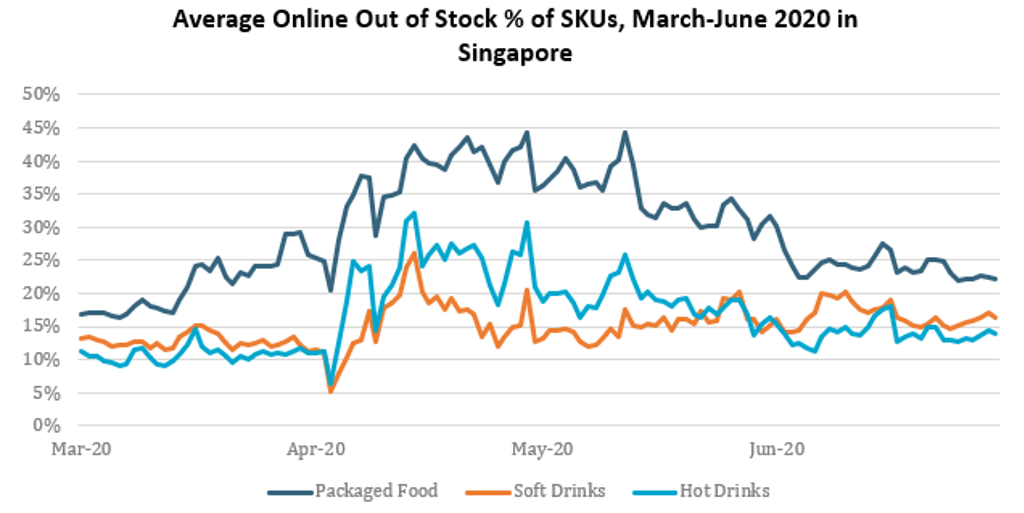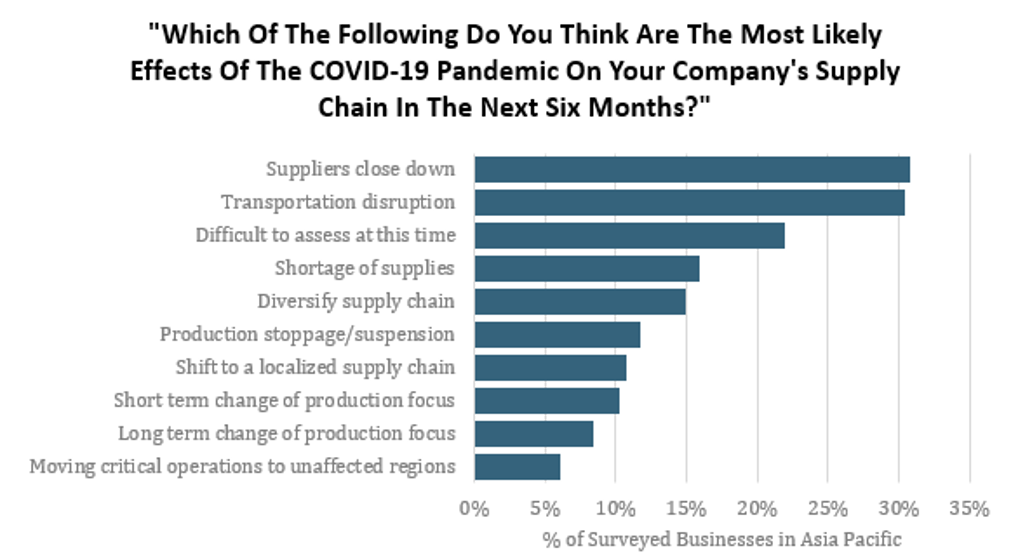Across Southeast Asia, food was categorised as an essential good during national lockdowns and was saved from major supply chain shocks during the onset of COVID-19 in early 2020. Cross-border trade was still in motion and most businesses adjusted their freight and logistics strategies. Less strenuous impact on businesses includes shortage of certain SKUs, shipment delays, and a pause on the introduction of new products for the rest of the year. Singapore, for example, recorded a peak of 44% of out-of-stock packaged food SKUs in May 2020, while hot and soft drinks saw a similar trend.
Source: Euromonitor International Via Daily Out-of-Stock Tracking
During this period, multinational companies had greater scale to focus on core SKUs and adjusted their product mix to fulfil the surge in demand and to minimise costs. For example, Gardenia (QAF Ltd) focused production on its bread products like white and wholemeal loaves. With its factories reportedly running at full capacity, empty shelves were largely temporary at the peak of the pandemic.
Despite these short-term challenges, packaged food has been one of the better performing FMCG industries in Southeast Asia. Consumption occasions have shifted into the home and consumers have focused their spending on essentials, seeking retail products more than ever before. Most packaged food categories are set to see better results in 2020 than was initially forecast in 2019, with cooking ingredients and meals and staple foods as key drivers.
Source: Euromonitor International Packaged Food Forecast Dashboard
Thailand is the only market where growth has been dampened (as a result of a fall in retail value sales for dairy and snacks) yet its forecast CAGR indicates that it will remain a lucrative market for packaged food up to 2025.
Greater focus on the resilience of the food industry
Labour shortages and movement restrictions have proved key challenges, emphasising the need to ensure the long-term resilience of the food industry. For example, a June 2020 study from the Southeast Asian Regional Center for Graduate Study and Research in Agriculture (SEARCA), found that a decline in agricultural farm labour could affect more than 100 million individuals and agricultural output in the region. Indonesia, one of the top five producers of agricultural products globally in 2019, is forecast by Euromonitor International to undergo an eight percentage point drop in GDP growth year-on-year in 2020.
This may affect consumers’ purchasing power and significantly alter trends and behavioural habits, causing a knock-on effect on demand for the types of packaged food products they may seek in future.
Focus strategies for long-term resilience in Southeast Asia
Packaged food is perceived to have gone through quality assurance processes that can promise better food safety and hygiene than fresh food. Businesses must be ready to optimise their production capacities and return to innovation in order to attract consumers to their brands and cater to new behaviours and needs. Consumers in Southeast Asia may be more cautious in spending, but their knowledge of trends and desires from pre-COVID-19 days remain.
Source: Euromonitor International Voice of the Industry Survey, October 2020; n=214
According to a survey conducted across businesses in Asia Pacific, the closure of supply chains and disrupted transportation will likely remain a persistent difficulty into the opening months of 2021, according to more than 30% of respondents. Yet, the percentage of respondents who say their company plans to diversify or shift to a localised supply chain is only 15% and 11% respectively, indicating some inertia in adapting.
Thailand-based Charoen Pokphand Foods’ 2019 acquisition of Canada-based Hylife Ltd with its Japanese partner, Itochu Corp, is a good example of diversification. The move could provide Charoen Pokphand Foods with a greater opportunity to expand its distribution to North America and Japan in addition to its main markets within Southeast Asia. This also opens up an opportunity to other pork-consuming markets given that Hylife is a massive pork producer in Canada.
A sustainable supply chain will also boost e-commerce
Amidst increasing consumer sophistication, despite dampened purchasing power, companies must aim for efficiency and transparency to minimise losses yet keep prices affordable.
Sustainable supply chains are not only for the benefit of businesses but also for consumers. With the use of e-commerce accelerating in grocery, digital traceability is also essential to ensure transparency, contact tracing and to identify food sources as consumers become more aware of these factors when buying through e-commerce platforms.

Source: Euromonitor International
For instance, Indonesia’s forecast growth is a consequence of the government’s commitment to training small-medium enterprises (SMEs) in optimising logistics for e-commerce space, alongside strong performance expected for packaged food up to 2025. In the long-term, government policies, company operations and strategic partnerships that are united in preventing future risks will better prepare the region as food security concerns intensify.



